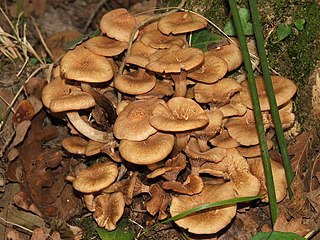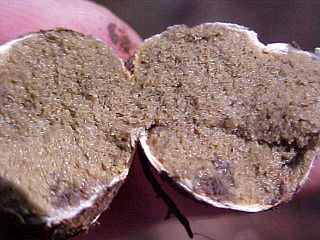
Symbiosis is any type of a close and long-term biological interaction between two biological organisms of different species, termed symbionts, be it mutualistic, commensalistic, or parasitic. In 1879, Heinrich Anton de Bary defined it as "the living together of unlike organisms". The term is sometimes used in the more restricted sense of a mutually beneficial interaction in which both symbionts contribute to each other's support.

Basidiomycota is one of two large divisions that, together with the Ascomycota, constitute the subkingdom Dikarya within the kingdom Fungi. Members are known as basidiomycetes. More specifically, Basidiomycota includes these groups: agarics, puffballs, stinkhorns, bracket fungi, other polypores, jelly fungi, boletes, chanterelles, earth stars, smuts, bunts, rusts, mirror yeasts, and Cryptococcus, the human pathogenic yeast.

Rusts are fungal plant pathogens of the order Pucciniales causing plant fungal diseases.

Ectosymbiosis is a form of symbiotic behavior in which an organism lives on the body surface of another organism, including internal surfaces such as the lining of the digestive tube and the ducts of glands. The ectosymbiotic species, or ectosymbiont, is generally an immobile organism existing off of biotic substrate through mutualism, commensalism, or parasitism. Ectosymbiosis is found throughout a diverse array of environments and in many different species.

Armillaria is a genus of fungi that includes the A. mellea species known as honey fungi that live on trees and woody shrubs. It includes about 10 species formerly categorized summarily as A. mellea. Armillarias are long-lived and form the largest living fungi in the world. The largest known organism covers more than 3.4 square miles (8.8 km2) in Oregon's Malheur National Forest and is estimated to be 2,500 years old. Some species of Armillaria display bioluminescence, resulting in foxfire.

In biology and medicine, a host is a larger organism that harbours a smaller organism; whether a parasitic, a mutualistic, or a commensalist guest (symbiont). The guest is typically provided with nourishment and shelter. Examples include animals playing host to parasitic worms, cells harbouring pathogenic (disease-causing) viruses, or a bean plant hosting mutualistic (helpful) nitrogen-fixing bacteria. More specifically in botany, a host plant supplies food resources to micropredators, which have an evolutionarily stable relationship with their hosts similar to ectoparasitism. The host range is the collection of hosts that an organism can use as a partner.

Armillaria mellea, commonly known as honey fungus, is an edible basidiomycete fungus in the genus Armillaria. It is a plant pathogen and part of a cryptic species complex of closely related and morphologically similar species. It causes Armillaria root rot in many plant species and produces mushrooms around the base of trees it has infected. The symptoms of infection appear in the crowns of infected trees as discoloured foliage, reduced growth, dieback of the branches and death. The mushrooms are edible but some people may be intolerant to them. This species is capable of producing light via bioluminescence in its mycelium.

The ant–fungus mutualism is a symbiosis seen between certain ant and fungal species, in which ants actively cultivate fungus much like humans farm crops as a food source. There is only evidence of two instances in which this form of agriculture evolved in ants resulting in a dependence on fungi for food. These instances were the attine ants and some ants that are part of the Megalomyrmex genus. In some species, the ants and fungi are dependent on each other for survival. This type of codependency is prevalent among herbivores who rely on plant material for nutrition. The fungus’ ability to convert the plant material into a food source accessible to their host makes them the ideal partner. The leafcutter ant is a well-known example of this symbiosis. Leafcutter ants species can be found in southern South America up to the United States. However, ants are not the only ground-dwelling arthropods which have developed symbioses with fungi. A similar mutualism with fungi is also noted in termites within the subfamily Macrotermitinae which are widely distributed throughout the Old World tropics with the highest diversity in Africa.

Epichloë is a genus of ascomycete fungi forming an endophytic symbiosis with grasses. Grass choke disease is a symptom in grasses induced by some Epichloë species, which form spore-bearing mats (stromata) on tillers and suppress the development of their host plant's inflorescence. For most of their life cycle however, Epichloë grow in the intercellular space of stems, leaves, inflorescences, and seeds of the grass plant without incurring symptoms of disease. In fact, they provide several benefits to their host, including the production of different herbivore-deterring alkaloids, increased stress resistance, and growth promotion.

Armillaria tabescens is a species of fungus in the family Physalacriaceae. It is a plant pathogen. The mycelium of the fungus is bioluminescent.

Stereum sanguinolentum is a species of fungus in the Stereaceae family. A plant pathogen, it causes red heart rot, a red discoloration on conifers, particularly spruces or Douglas-firs. Fruit bodies are produced on dead wood, or sometimes on dead branches of living trees. They are a thin leathery crust of the wood surface. Fresh fruit bodies will bleed a red-colored juice if injured, reflected in the common names bleeding Stereum or the bleeding conifer parchment. It can be the host of the parasitic jelly fungus Tremella encephala.

Puccinia monoica is a parasitic rust fungus of the genus Puccinia that inhibits flowering in its host plant and radically transforms host morphology in order to facilitate its own sexual reproduction.

Ceratobasidium is a genus of fungi in the order Cantharellales. Basidiocarps are effused and the genus is sometimes grouped among the corticioid fungi, though species also retain features of the heterobasidiomycetes. Anamorphic forms were formerly referred to the genus Ceratorhiza, but this is now considered a synonym of Rhizoctonia. Ceratobasidium species, excluding the type, are also now considered synonymous with Rhizoctonia and some species have been transferred to the latter genus. Species are saprotrophic, but several are also facultative plant pathogens, causing a number of commercially important crop diseases. Some are also endomycorrhizal associates of orchids.

Rhizopogon vinicolor is a species complex of ectomycorrhizal fungus which forms a mutualistic relationship with the Douglas-fir. The species was first described scientifically by American mycologist Alexander H. Smith in 1966.

Helicobasidium is a genus of fungi in the subdivision Pucciniomycotina. Basidiocarps are corticioid (patch-forming) and are typically violet to purple. Microscopically they have auricularioid basidia. Asexual anamorphs, formerly referred to the genus Thanatophytum, produce sclerotia. Conidia-bearing anamorphs are parasitic on rust fungi and are currently still referred to the genus Tuberculina.

Amylostereum is the single genus in the fungal family Amylostereaceae. The genus currently comprises four saprotrophic and parasitic species, which live off living or dead wood. The Amylostereaceae cause white rot in the wood by disintegrating the tissue component lignin. They produce crust-like, partially wavy fruit bodies on the surface of infested trees, which are similar to those produced by Stereum species.
Hemiberlesia lataniae, the latania or palm scale, is a species of armored scale insect in the family Diaspididae. It was first described by the French entomologist Victor Antoine Signoret in 1869 using Latania lontaroides, a species of palm tree endemic to Réunion as its host; since then, it has been found on avocado trees growing in South Africa, Australia, Israel, the United States, and on a range of other plants in many parts of the world.

Botryobasidium is a genus of corticioid fungi belonging to the order Cantharellales. Basidiocarps are ephemeral and typically form thin, web-like, white to cream, effused patches on the underside of fallen branches, logs, and leaf litter. Several species form anamorphs producing chlamydospores. All species are wood- or litter-rotting saprotrophs and the genus has a worldwide distribution.

Exobasidium camelliae is a phytopathagenic fungus that infects ornamental shrubs of the Camellia genus. It absorbs nutrients from the host through its haustoria and causes the leaves of the host plant to be thicker and lighter green than usual. It forms a hymenium between cells four to six layers above the lower epidermis which is subsequently sloughed off to reveal its basidia.
The Septobasidiales are an order of rust fungi in the class Pucciniomycetes. It contains the single family Septobasidiaceae, which itself comprises six genera: AphelariopsisJülich, AuriculoscyphaD.A. Reid & Manim., CoccidiodictyonOberw., JohncouchiaS. Hughes & Cavalc., SeptobasidiumPat. and lastly, UredinellaCouch.

















